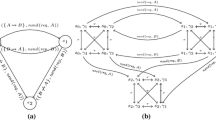Abstract
The election model can be used as a composing element to solve many practical problems such as mutual exclusion, consensus problem and reliable broadcasting in which a control function would be useful. This model has been deeply examined in the study group since the motive for this much interest is that networked computer system paradigms require a coordinator such as leader. In spite of its importance, there is only a few study that has been contributed to this coordinator election model in an ad hoc distributed system. Mobile distributed computing systems are more inclined to faults than traditional computer systems. To build an election protocol in such a mobile computing environment is not trivial. Because it is difficult task to choose a unique process from a group of mobile processes as a coordinator in spite of failures or disconnections of mobile processes. In this paper, we present an election protocol in mobile ad hoc distributed systems and we discuss some simulation results.




Similar content being viewed by others
References
LeLann G (1977) Distributed systems—towards a formal approach. In: Gilchrist B (ed) Information processing, vol 77. North-Holland, Amsterdam
Gholipour M, Kordafshari MS, Jahanshahi M, Rahmani AM (2009) A new approach for election algorithm in distributed systems. In: International Conference on Communication Theory, Reliability, and Quality of Service. pp 70–74
Arabnia Hamid R (1996) Distributed stereocorrelation algorithm. In: International Journal of Computer Communications, Elsevier Science, pp 707–712
Arabnia Hamid R, Bhandarkar SM (1996) Parallel stereocorrelation on a reconfigurable multi-ring network. J Supercomput Spec Issue Parallel Distrib Process 10(3):243–270
Arabnia Hamid R, Taha Thiab R (1998) A parallel numerical algorithm on a reconfigurable multi-ring network. J Telecommun Syst Spec Issue Interconnect Netw 10:185–203
Sung-Hoon Park, Seon-Hyong Lee (2014) Quorum-based mutual exclusion in asynchronous distributed systems with unreliable failure detectors. J Supercomput 67(2):469–484
Sung-Hoon Park (2007) The election problem in asynchronous distributed systems with bounded faulty processes. J Supercomput 41(1):89–104
Garcia-Molian H (1982) Elections in a distributed computing system. IEEE Trans Comput C–31(1):49–59
Abu-Amara H, Lokre J (1994) Election in asynchronous complete networks with intermittent link failures. IEEE Trans Comput 43(7):778–788
Sayeed HM, Abu-Amara M, Abu-Avara H (1995) Optimal asynchronous agreement and leader election algorithm for complete networks with byzantine faulty links. Distrib Comput 9(3):147–156
Brunekreef J, Katoen J-P, Koymans R, Mauw S (1996) Design and analysis of dynamic leader election protocols in broadcast networks. Distrib Comput 9(4):157–171
Singh G (1996) Leader election in the presence of link failures. IEEE Trans Parallel Distrib Syst 7(3):231–236
Lin C, Gerla M (1997) Adaptive clustering for mobile wireless networks. IEEE J Sel Areas Commun 15(7):1265–75
Gomez-Calzado C, Larrea M (2013) An evaluation of efficient leader election algorithms for crash-recovery systems. In: 2013 21st Euromicro International Conference on Parallel, Distributed and Network-Based Processing. pp 180–188
Zargarnataj M (2007) New election algorithm based on assistant in distributed systems. In: Computer Systems and Applications. ACS/IEEE International Conference. pp 324–331
Arif Wani M, Arabnia Hamid R (2003) Parallel edge-region-based segmentation algorithm targeted at reconfigurable multi-ring network. J Supercomput 25(1):43–63
Valafar H, Arabnia Hamid R, Williams G (2004) Distributed global optimization and its development on the multiring network. Int J Neural Parallel Sci Comput 12(4):465–490
Buhari AHR (2004) Running multicast applications using reconfigurable parallel system. Int J Comput Inform Sci (IJCIS-ISSN 1708-0460) 2(2):108–113
Pradhan DK, Krichna P, Vaidya NH (1996) Recoverable mobile environments: design and tradeoff analysis. In: FTCS-26
Basu P, Khan N, Little T (2001) A mobility based metric for clustering in mobile ad hoc networks. In: International Workshop on Wireless Networks and Mobile Computing
A consensus-based leader election algorithm for wireless ad hoc networks found. In: Computer, Consumer and Control. International Symposium on By Hsu-Chia Cahng, Chi-Chun Lo, Issue Date: June 2012. pp 232–235
Malpani N, Welch J, Vaidya N (2000) Leader election algorithms for mobile ad hoc networks. In: Fourth International Workshop on Discrete Algorithms and Methods for Mobile Computing and Communications, Boston, MA
Hatzis K, Pentaris G, Spirakis P, Tampakas V, Tan R (1999) Fundamental control algorithms in mobile networks. In: Proceedings of 11th ACM SPAA. pp 251–260
Derhab A, Badache N (2008) A self-stabilizing leader election algorithm in highly dynamic ad hoc mobile networks. In: IEEE Transactions on Parallel and Distributed Systems. pp 926–939
Kardas M, Klonowski M, Pajak D (2013) Energy-efficient leader election protocols for single-hop radio networks. In: 2013 42nd International Conference on Parallel Processing (ICPP). pp 399–408
Chung HC, Welch JL, Robinson P (2011) Optimal regional consecutive leader election in mobile ad-hoc networks. In: Proceedings of the 7th ACM ACM SIGACT/SIGMOBILE International Workshop on Foundations of Mobile Computing (FOMC ’11). pp 52–61
Zeng X, Bagrodia R, Gerla M (1998) GloMoSim: a library for parallel simulation of large-scale wireless networks. In: Proceedings of 12th Workshopon Parallel and Distributed Simulations, Alberta, Canada
Powell D (1996) Special section on group communication. Commun ACM 39(4):50–97
Acknowledgements
This research was supported by Basic Science Research Program through the National Research Foundation of Korea (NRF) funded by the Ministry of Education (2017R1D1A1B03034955) and the second Brain Korea 21 PLUS project.
Author information
Authors and Affiliations
Corresponding author
Rights and permissions
About this article
Cite this article
Park, S., Yoo, S. & Kim, B. An election protocol based on group membership detection algorithm in mobile ad hoc distributed systems. J Supercomput 74, 2239–2253 (2018). https://doi.org/10.1007/s11227-018-2258-0
Published:
Issue Date:
DOI: https://doi.org/10.1007/s11227-018-2258-0




